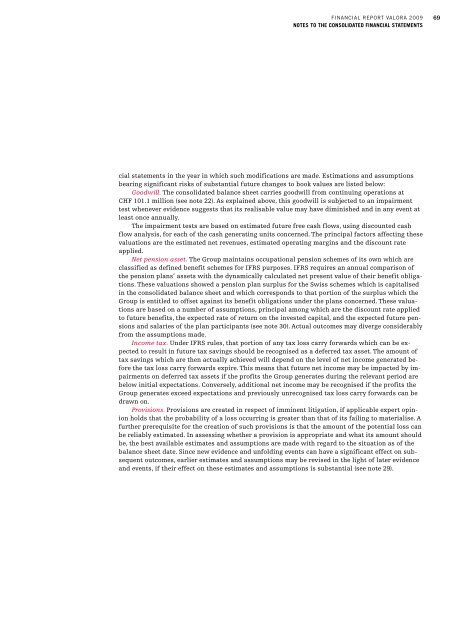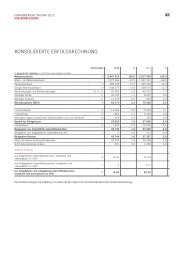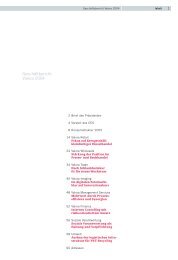PDF (3.6 MB) - Valora
PDF (3.6 MB) - Valora
PDF (3.6 MB) - Valora
Create successful ePaper yourself
Turn your PDF publications into a flip-book with our unique Google optimized e-Paper software.
Financial RepoRt ValoRa 2009<br />
notEs to tHE consolIdatEd fInancIal statEmEnts<br />
cial statements in the year in which such modifications are made. Estimations and assumptions<br />
bearing significant risks of substantial future changes to book values are listed below:<br />
Goodwill. The consolidated balance sheet carries goodwill from continuing operations at<br />
CHF 101.1 million (see note 22). As explained above, this goodwill is subjected to an impairment<br />
test whenever evidence suggests that its realisable value may have diminished and in any event at<br />
least once annually.<br />
The impairment tests are based on estimated future free cash flows, using discounted cash<br />
flow analysis, for each of the cash generating units concerned. The principal factors affecting these<br />
valuations are the estimated net revenues, estimated operating margins and the discount rate<br />
applied.<br />
Net pension asset. The Group maintains occupational pension schemes of its own which are<br />
classified as defined benefit schemes for IFRS purposes. IFRS requires an annual comparison of<br />
the pension plans’ assets with the dynamically calculated net present value of their benefit obligations.<br />
These valuations showed a pension plan surplus for the Swiss schemes which is capitalised<br />
in the consolidated balance sheet and which corresponds to that portion of the surplus which the<br />
Group is entitled to offset against its benefit obligations under the plans concerned. These valuations<br />
are based on a number of assumptions, principal among which are the discount rate applied<br />
to future benefits, the expected rate of return on the invested capital, and the expected future pensions<br />
and salaries of the plan participants (see note 30). Actual outcomes may diverge considerably<br />
from the assumptions made.<br />
Income tax. Under IFRS rules, that portion of any tax loss carry forwards which can be expected<br />
to result in future tax savings should be recognised as a deferred tax asset. The amount of<br />
tax savings which are then actually achieved will depend on the level of net income generated before<br />
the tax loss carry forwards expire. This means that future net income may be impacted by impairments<br />
on deferred tax assets if the profits the Group generates during the relevant period are<br />
below initial expectations. Conversely, additional net income may be recognised if the profits the<br />
Group generates exceed expectations and previously unrecognised tax loss carry forwards can be<br />
drawn on.<br />
Provisions. Provisions are created in respect of imminent litigation, if applicable expert opinion<br />
holds that the probability of a loss occurring is greater than that of its failing to materialise. A<br />
further prerequisite for the creation of such provisions is that the amount of the potential loss can<br />
be reliably estimated. In assessing whether a provision is appropriate and what its amount should<br />
be, the best available estimates and assumptions are made with regard to the situation as of the<br />
balance sheet date. Since new evidence and unfolding events can have a significant effect on subsequent<br />
outcomes, earlier estimates and assumptions may be revised in the light of later evidence<br />
and events, if their effect on these estimates and assumptions is substantial (see note 29).<br />
69






